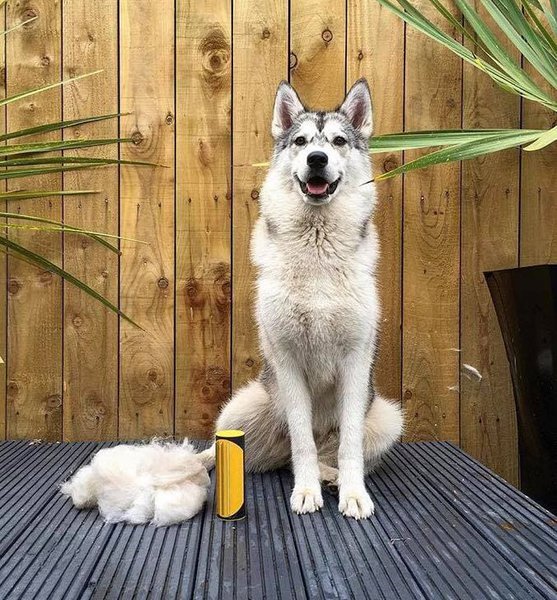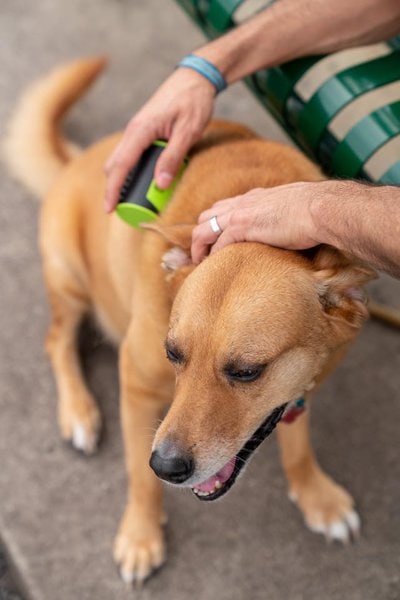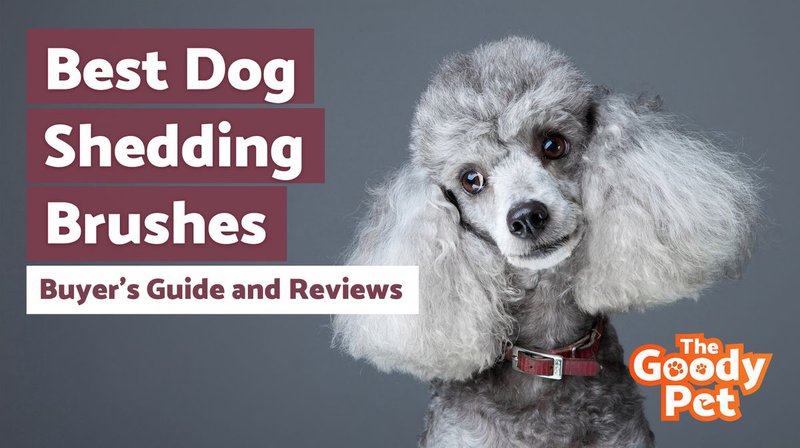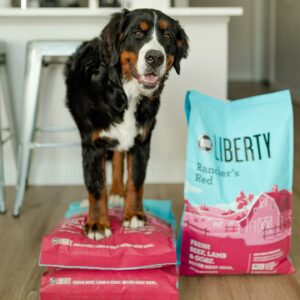The best dog shedding brush is FURminator Short Haired Dog Deshedding Tool.
If you own a dog, shed season is a whole lot more than just an occasional annoyance. No matter how much you love your dog, nobody wants to live in a house that resembles a snow globe, and all it takes is one misplaced lamp to start a cascade of fur. (But with a little preparation, you can avoid that fate.)
A dog shedding brush is a tool that every dog owner should own (unless they have a poodle or another dog that doesn’t shed). This is a brush that will not only collect fur and prevent it from getting all over your clothes and carpet but will also help to reduce shedding in the future, hence the term “deshedding”.
In this article, you’ll learn 8 of the best dog shedding brushes and discover how and why to make use of them.
#1 FURminator Undercoat Dog Deshedding Tool
This product almost deserves to be our top pick for the name alone! Apart from the excellent pun though, there is a lot to like here.
For one, the FURminator uses a stainless-steel edge that will help to reach through the topcoat and remove trapped loose hair. At the same time, it also comes with an extremely useful “FURejector” button which will release the loose hair that it has collected on the way. This makes a massive difference to the usability of the device and is something that any similar product can benefit from.
The brush also comes in three different sizes, and two configurations for long-haired and short-haired dogs. This way, you can ensure that you’ll be able to find the ideal product for your pooch.
It works equally well on the undercoat too. The teeth on the comb are able to penetrate deeply into your dog’s coat, so you are able to brush out the undercoat which is essential to avoid hair matting.
The real winner here is that ejector button which helps to make the process of combing your dog significantly easier and quicker. But otherwise, this is just a very well-made product that dogs enjoy being brushed with and that owners enjoy using!
Pros
- The FURminator deshedding tool features a stainless steel edge that is designed to reach through a pooch’s topcoat and easily remove a pooch’s loose undercoat hair.
- Customers can utilize the FURejector button on this canine deshedding tool to get rid of collected hair with ease.
- The safe design of this brush’s edge ensures that customers don’t injure their dogs’ skin while getting rid of loose undercoat hair.
- The ergonomic design of this deshedding tool provides a comfortable handling experience for users and ensures that the brush can be effectively maneuvered to trim a pooch’s undercoat.
- This canine undercoat tool is available in 3 size options – Small, Medium, and Long – as well as two different style options – short hair and long hair – to cater to a wide variety of dog hair lengths, thicknesses, and sizes.
Cons
- Several customers have commented that this brush’s handle has a tendency to break off while in use.
- The fur release button of this deshedding tool isn’t always reliable, and some customers have reported needing to manually get rid of dog hair collected while deshedding.
This product emerges as the top pick because it effectively controls shedding up to as much as 90% and its stainless steel bristles do not damage the coat or injure the dogs’ skin in any way.
#2 MIU COLOR Pet Deshedding Tool
This deshedding tool is our budget pick, meaning that it is affordable for those with a little less to spend, without cutting any major corners.
So, what is it about this brush that makes it a winner despite its more affordable price? Well for one, this brush is once again well made with an ergonomic non-slip handle and stainless-steel edge. At the same time, it is also once again very easy to clean. That’s thanks to a detachable head which you can then use to remove any loose fur.
There’s also a handy cover for protecting the edge and increasing the lifespan of the product.
Despite coming with so many thoughtful features and design decisions, the MIU COLOR still manages to be extremely affordable. It’s eco-friendly too, so it’s a winner all-round.
Pros
- This canine deshedding brush features a detachable comb head that can be removed, with a quick-release button, to conveniently get rid of collected dog hair.
- The safe blade cover that comes with the MIU deshedding tool helps protect the brush’s teeth from damage.
- MIU COLOR’s deshedding tool features uniformly distributed teeth that are effective for removing dead undercoat hair and stimulating better skin blood circulation.
- The inclusion of a hole in this brush’s handle makes for customers to store the brush by hanging when it is not being used.
- The non-slip rubber used on this brush’s handle provides users with a firm grip and ensures that customers can enjoy a comfortable dog deshedding experience.
Cons
- Several customers have commented that the teeth on the short and medium-hair variants of this deshedding tool don’t go deep enough to remove a dog’s undercoat hair.
- This brush’s teeth tend to get clogged up with dog hair, with users constantly needing to stop and pull out the hair before continuing.
#3 HappyDogz Deshedding Brush
This option from HappyDogz is another excellent choice with a lot going for it – so it makes happy owners too.
The tool promises to reduce shedding for dogs and cats by up to 95% and has a removable head to make things nice and easy. The ergonomic and textured non-slip handle also makes this a pleasant item to use.
With all that said, there isn’t a lot about the HappyDogz Deshedding Brush that really sets it apart from the crowd – it’s a fairly generic brush in that regard.
This is a ‘textbook’ brush that does everything you could probably be looking for. It’s highly rated by dog owners, with an average rating of 4.5/5.0 among 2600 reviews.
Pros
- The HappyDogz deshedding brush is available in various size options to cater to the deshedding needs of small, medium, and large dogs.
- The ergonomic handle design featured on this deshedding brush provides a firm grip and also ensures that customers can comfortably carry out lengthy grooming sessions.
- This canine deshedding tool features a quick-release button that makes it easy for customers to remove the brush’s blades for cleaning when needed.
- The inclusion of an eyelet in this brush’s handle provides an avenue for customers to store the brush by hanging and also puts the brush within reach.
- The 4-inch brush featured on this canine deshedding brush covers a considerable area of the dog coat and ensures that deshedding sessions can proceed faster.
Cons
- There are multiple reports of this deshedding brush’s handle breaking easily.
- This deshedding brush reportedly features sharp bristles that can injure a pooch’s skin, if not used carefully.
#4 Paws & Pals Dog Hair Brush Grooming Comb
This dog grooming brush is extremely affordable which will make it a winner for many pet owners. It also has a few other things going for it. For one, the bristles claim to be ‘self-cleaning’ and can thereby reduce the time and work on your part.
Another great aspect is that this comb is designed to be gentle – reassuring for owners who might otherwise worry that they are hurting their pets.
There’s a lot to like about this comb along with the small price then. That said, it isn’t perfect: the small handle means it can be a little more tiring to maneuver through thick fur. And as there is only one size, it won’t be as tailored as some of the other brushes on this list for the size of your dog or the thickness of their coat.
Pros
- Paws & Pals’ deshedding brush has stainless steel blades that can effectively get rid of loose dog hair without injuring or irritating the pooch’s skin.
- Paws & Pals’ dog grooming comb features an innovative self-cleaning design that makes it easier for customers to get rid of collected loose hair.
- Constant use of this canine grooming comb helps prevent the formation of hair mats, stimulates the distribution of natural skin oils, and also helps avoid the unsavory odor that is typical with poorly groomed pooches.
- The handle on this canine grooming comb ensures an ergonomic grip that provides customers with the comfort and control needed to carry out deshedding exercises without straining their hands.
- This canine deshedding brush is one of the more affordable options on this list of the best deshedding brushes for dogs.
Cons
- This dog deshedding brush is available in only one size option and is not effective with all dog hair types and lengths.
- The considerably wide spacing between this brush’s bristles results in customers needing to spend more time trimming their pooches’ undercoats.
#5 PetNeat Pet Grooming Brush
This pet grooming brush doesn’t have much branding – it is simply called “Pet Grooming Brush.” That can sometimes be a warning sign and especially given that this isn’t the cheapest item on this list.
Nevertheless, it’s still a very reliable and well-made brush. Just one size again, which is unfortunate, but it promises to remove up to 95% of loose hair. The bristles are 100mm, and it comes with a cover to protect the blade.
And perhaps even more impressive is the fact that this brush comes with a 100% money-back guarantee.
The money guarantee should put to rest any concerns about the branding. Other than that, this is another very serviceable brush, despite not having anything uniquely exciting to write home about.
Pros
- The PetNeat grooming brush features a quick-release button that makes it possible for customers to quickly and easily remove the brush’s stainless steel comb for cleaning.
- The blade cover that comes with this canine deshedding tool helps protect the brush’s teeth from damage from external factors.
- The soft, anti-slip handle of this grooming brush provides users with a firm and comfortable grip that enhances the product’s ease of use.
- The 4-inch long, rust-resistant stainless steel blades featured on this canine grooming brush are designed to effectively reach and get rid of loose hair in a dog’s undercoat.
- This canine deshedding package from PetNeat contains 4 bonus eBooks that provide customers with valuable information and tips on how to effectively groom their pooches.
Cons
- Multiple reviews about this canine deshedding brush not being effective at getting rid of dead undercoat hair.
- This brush’s teeth tend to quickly get filled up with hair and customers have to frequently stop to get rid of this hair, thereby making the deshedding process tedious.
#6 Thunderpaws Professional De-Shedding Brush
You’ve heard of Thundercats… this is the Thunderpaws deshedding brush. Which is actually for both Thundercats and Thunder…dogs.
This brush is a professional grade with a premium, stainless steel build. That’s high-quality given the mid-range price point. It also comes with an ergonomic, non-slip handle, and another excellent lifetime warranty.
This is another example of a great brush that nevertheless has no real bells or whistles. It is competently made, and you can buy with confidence.
Pros
- Thunderpaws’ professional deshedding brush comes with a quick-release button that makes it easy for customers to detach the brush’s blades to remove collected hair and carry out other maintenance activities.
- This canine deshedding brush product features a 4-inch stainless steel comb that is generally gentle on a pooch’s coat and a cover is included in the package to protect these teeth from damage.
- This dog deshedding brush features non-slip handles that are ergonomically designed to provide customers with a comfortable and firm grip during grooming sessions.
- This canine deshedding product comes with a lifetime warranty that covers damages that occur due to the manufacturer’s fault.
- Customers can conveniently hang up and store this deshedding brush, thanks to the inclusion of an eyelet in the brush’s handle.
Cons
- The absence of a hair release button on this deshedding brush results in customers needing to manually get rid of collected hair once the brush’s teeth is clogged up.
- Multiple owners of pooches with different hair lengths – short, medium and long – have commented that this brush isn’t effective at removing their pooches’ loose undercoat hair.
#7 CleanHouse Dog Slicker Brush
The CleanHouse Dog Slicker Brush is a mid-range offering in terms of pricing but is somewhat unique in terms of design. Unlike other options here, this product does not come with a blade but rather features bristles on the bottom of the flathead. This makes it a little gentler and also helps it to more ergonomically travel around your dog’s body and contours.
The CleanHouse Dog Slicker Brush also comes with what we’ve already outlined as one of the very best features of these products: an easy-clean button. Just click and it will extend the bristles, ejecting the hair. This is actually one of the most effective of these types of brushes
Other than that, you have a nicely made brush that is colorful and comfortable to hold and use.
We particularly liked this slicker brush owing to the unique design which will make it a little comfier for your dog. It’s self-cleaning which is a big win, has a money-back guarantee, and is affordable. The only shame is that there aren’t different sizes and options for types of hair.
Pros
- CleanHouse’s Slicker brush features rubber ends on each bristle to ensure that dogs don’t feel pain and to protect pooches’ skin from injuries while deshedding.
- The self-cleaning design of this canine deshedding tool makes it convenient for customers to get rid of collected hair by clicking the hair-release button on the brush.
- The flathead design of this dog shedding brush covers a considerably wider area of a pooch’s coat and ensures that grooming sessions can proceed faster.
- CleanHouse Dog Slicker Brush comes with a lifetime warranty that covers damages, resulting from poor manufacturing, to the product.
- The rubber cover on this brush’s handle provides customers with a comfortable grip for stress-free grooming sessions.
Cons
- Several customers claim that they have had to hold down on this brush’s bristle retraction button for the bristles to stay in place while brushing their pooch’s coat, thereby making the entire deshedding process more tedious.
- The bulky design of this dog brush may not be comfortable to use for those with small hands.
#8 Hertzko Dog Deshedding Tool
The last entry on our list is a little sleeker-looking than some of the others we’ve looked at so far with a neat black and purple design. Not that this is really what you tend to look for when buying dog brushes.
This grooming tool is really comfortable and comes with an anti-slip grip handle. When not in use, you can also slip on the blade protector attachment to prevent any accidental injuries.
It’s also easy to clean seeing as the head is removable (though the easy clean buttons are preferable here). It comes with a money-back guarantee, and it has an anti-slip wrist strap. That last feature is a little odd though, does it really matter if you drop a comb?
Not the most standout option on our list then, but still definitely a contender thanks to a slew of thoughtful features and one of the best-looking designs we’ve seen.
Pros
- Hertzko’s dog deshedding tool features a comfortable anti-slip handle design that helps to prevent the hand strain typical with long grooming sessions.
- The thumb rest embedded onto this canine deshedding tool provides users with more control and stability while grooming their pooch’s coat.
- Customers can utilize the quick-release button that comes with this canine deshedding tool to easily remove the brush’s blade for easy cleaning.
- The high-quality, rust-resistant stainless steel material used in crafting this canine deshedding tool is generally safe to use on a pooch’s skin and coat.
- The all-in-one design of the Hertzko dog deshedding tool is intended for use with various dog hair types and lengths including long, medium, thick and curly hair.
Cons
- Customers claim that this Hertzko deshedding tool doesn’t pick up loose undercoat hair, unless considerable pressure is applied, thereby requiring more effort during brushing.
Dog Shedding Brushes Buyer’s Guide
So those are the top 8 dog shedding brushes. We have researched thoroughly on each of them and can, therefore, provide assurance of their quality and their effectiveness.
But if you are looking for a little more help when it comes to choosing which one is right for you and your pooch, then it would be helpful to better understand how they work, what the different features all mean, and how to use them. This way, you can get the most from your new brush and also be better able to make future purchasing decisions.
With that in mind then, this is our dog shedding brush buyer’s guide.
Related: Best Dog Brushes For Short Hair Dogs
Benefits of a Dog Deshedding Brush
First, let’s look at what you are going to be using a deshedding brush for and why it is such an invaluable tool.
Of course, a canine deshedding brush primarily does exactly what it says on the tin: it allows you to brush your dog in order to minimize shedding. This will remove loose fur that is currently embedded beneath your canine’s topcoat. And by doing that, you’ll enjoy a number of different benefits.
The first benefit is that you’ll have much cleaner carpets and clothes. Anyone who owns a dog that sheds a lot of furs will know just how much of a problem it can be.
You’ve just put on a new black suit or black dress, and you’re ready to head out for the night. Then you look down and you realize that it’s covered in countless tiny white loose hairs – which does somewhat undermine your look. You’ve gone from classy and sophisticated to ‘crazy dog person’ in two seconds flat!
The same goes for your home. Canine loose hairs have an unfortunate tendency to get all over everything, from your carpet and your furniture to your sideboards and your bed. This is unhygienic, of course, and it also looks bad. At that point, you will need a specially designed pet vacuum to get all that fur out.
The problem is that as your dog’s fur sheds, it gets caught in all the fur that is still there. This then means that when they start running around and playing, it will come loose and leave a trail of furry destruction in their wake. Now you have hair strewn all over the house.
Lesser Fur, Lesser Odors
Oh, and it smells a bit too. As much as we love dogs, we’d be lying if we said that they smelled great. That bad odor, unfortunately, comes from the dead and loose hair, and so the more your dog sheds, the more that odor is going to be left all around the house.
Related: Best Pet Air Purifiers

How Does It Work?
Simple: it will brush through the top layer of healthy fur and penetrate down to where the unwanted loose fur and loose hairs are hiding. They will then get removed by the brush and collected at once. If your pooch is a breed that sheds a lot like the German Shepherd – the very same breed the 46th POTUS has, you will end up quite a pile of loose fur and loose hairs.
Your canine companion has now been “deshed” meaning that they have done all their shedding for a while. Loose hair will continue to fall out, sure, but it will mostly be caught in that topcoat. That means in turn that you won’t get a lot of fur coming out everywhere until a significant amount has built up once again and the coat becomes “saturated”.
All you need to do is to brush your dog frequently enough to prevent it from getting to that point again.
We really can’t recommend using a product like this enough. The smell and the loose fur are two of the most distracting and unfortunate aspects of owning a dog. But by constantly combing, you can mitigate the issue almost entirely.
More Brushing = Happier & Healthier Dog
So that’s one reason to keep brushing your furry friend. Another is that it is actually good for them.
Why is that? For lots of reasons actually.
Firstly, you’ll notice that your dog looks a lot healthier as soon as you brush them. You’ll find that the dead and loose hair that is no longer attached is not receiving nutrients. Therefore, it shouldn’t come as a huge surprise to learn that it isn’t going to be as vibrant or as glossy. The more of this dead fur is in your dog’s coat, the less healthy and vibrant your pooch will look in general.
This is the equivalent of giving your face a scrub and removing the dead skin in order to reveal that healthier, more colorful skin underneath. It can take years off!
Removing Excess Fur Is Important
The other reason to remove that dead fur is that it actually thickens the coat in an unhelpful manner – making it heavy, hot, and generally uncomfortable for your pup. This is especially important in the summer then.
And I know what you might be thinking: but shouldn’t we let nature do its thing? Well sure, we could… if we hadn’t completely removed our dogs from nature. For starters, most pooches now live in much warmer environments assuming that you are heating your home like most people.
And at the same time, dogs in the wild would have spent a lot more time running and playing – which would help to naturally remove that unwanted fur. Your dog likely spends a lot more time on their own and not playing – meaning that they aren’t getting the opportunity to freshen up their fur.
Of course, your pooch will also actually enjoy being combed. Dogs love being combed as it is essentially like getting a massage. This is a brilliant way for you to bond with your dog and to spend some time fussing with them. So while it might seem like a chore, that couldn’t be farther from the truth.
But none of this is the biggest reason to keep combing your dog. That would be the fact that this form of grooming can also actually improve their skin, prevent infections, and ultimately increase their lifespan.
Your canine’s fur will not only be weighed down by lots of loose hairs right now but also lots of dead skin. This creates more space for parasites to hide, and it prevents fresh air from making it to their skin.
On the other hand, if you keep combing, you will be able to remove those outer layers so that your four-legged companion is naturally nourished by the air and the sun. not only that, but they’ll also be able to benefit from increased blood circulation.

How to Use A Dog Deshedding Brush
The great news is that using a canine deshedding brush is extremely easy. In most cases, you will simply brush your dog’s coat, making sure to get every area where the fur is thick and where you might expect stray hairs to have built up.
You can brush your dog’s face lightly depending on their coat, but let them be your guide on this – if they seem uncomfortable then refrain. Obviously, you should be very careful around the eyes.
Usually, the advice is to deshed your canine’s coat about 1 to 2 times per week. However, you can let your dog be your guide here once again. If they seem to be shedding a lot of fur, then you might want to do this a little more frequently or for longer. Each session should last about ten minutes, and ideally, you should do it at a time when your furry friend is relaxed and happy for a hug and a massage. This will help to reduce shedding in the future too.
The only other tip you really need to keep in mind is that you should always comb in the direction that your pooch’s fur grows naturally. Don’t brush against the grain, or it might be uncomfortable. And in the worst-case scenarios, this might even lead to infections and other problems.
Features To Look For
While canine deshedding brushes are generally rather simple to understand then, there are a few additional things to look out for when making your choice.
Picking the right size comb is one useful tip. Likewise, you should look for combs that are designed for your dog’s fur length. It’s not uncommon to find brushes that let you buy different models for different sizes. Where you have a comb that is equally suited to large, small, and medium dogs, you should generally proceed with just a little bit of caution – they may in fact not be particularly suited to any size.
In terms of features, the most useful available is easy cleaning. If you can find a brush that will let you quickly eject fur, or that will let you detach the head in order to clean, then you’ll find that you spend a lot less time with the brush and that it generally looks much better and is much easier to use.
It’s also a good idea to look at the bristles (or ‘blade’) and just how sharp/comfortable they look. You ideally want something that’s going to do the job well enough (stainless steel is preferable) but that won’t be overly sharp.
Otherwise, an ergonomic brush is generally a good option, and if you can find one with a lifetime warranty then that’s, of course, a fantastic bonus.
Related: Best Dog Hair Hair Vacuum
Final Thoughts
These are just some of the things you need to know when choosing your canine deshedding brush. Ultimately, any of the products we’ve listed will be great choices for your dog and will help you to live in a much more hair-free home.
You should enjoy the bonding time too, and it’s great to know your furry companion will be heavier as a result too!





